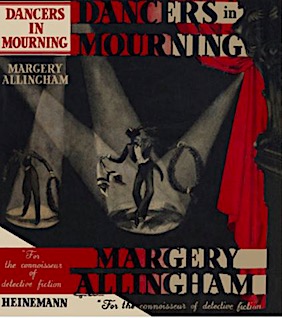A fine prose style and a masterly handling of narrative mechanics will take a writer quite a long way. In the mid-1930s, Allingham gained a reputation as one of a handful of English detective novelists who were applying a welcome gloss of literary refinement to their chosen genre, and this book justifies that assessment. Take the moment when death makes its appearance at White Walls, the country estate of Jimmy Sutane, a West End dancing sensation (who bears a loose resemblance to Fred Astaire). Allingham describes the scene as Sutane and two other men, including the gentleman sleuth Albert Campion, approach the spot where trauma has struck: “They came slithering down the high bank to the road, bringing great clods of the sandy yellow earth with them. The car stood in the middle of the lane, her engine still running, while behind, ghastly in the red glare of the tail-light, was something white and quiet on the grass verge.” The all-too-quiet “something” is the lifeless body of Chloe Pye, another dancer and a self-invited weekend guest; it had tumbled from an overpass in front of Sutane’s Bentley, which then ran over it. Was her demise an accident? Was it suicide? In time, of course, it will be revealed as a case of homicide. Two other killings follow, at roughly even intervals: Allingham, in this sojourn among theater folk, does a neat job of creating a three-act structure.
Allingham also successfully enmeshes a murder investigation within a novel of manners that doubles as a bittersweet tale of romance. Campion falls hard for Linda Sutane, the matron of White Walls, and his star-crossed obsession with that married woman casts a disabling pall over his crime-solving work.  This aspect of the narrative doesn’t always work, and it weakens the quality of detection that Campion undertakes. Yet Allingham, by dint of polished storytelling, makes his infatuation seem both real and relevant. (The trope of a genius detective bedazzled by feminine charms, by the way, goes back to the eponymous sleuth in Trent’s Last Case, or indeed to the first Sherlock Holmes short story, in which Irene Adler used her wiles to defeat the supposed Great Man.) The same general point applies to the limning of other characters. In addition to the Jimmy Sutane and his wife, the party at White Walls includes Eve Sutane, the dancer’s love-addled teenage sister; Dick Poyser, his sharp-eyed manager; “Sock” Petrie, his gangly young publicist; Benny Konrad, his predictably jealous understudy; Miss Finbrough, his nurse and all-around factotum; Squire Mercer, a self-involved composer who writes music for Sutane’s stage vehicles; and a few others. Simply to list these figures is to suggest that they are an off-the-shelf set of arty and upper-crust types. But Allingham imbues each of them with such particularity that all of them—even those who are deeply dislikable—come across as deeply sympathetic.
This aspect of the narrative doesn’t always work, and it weakens the quality of detection that Campion undertakes. Yet Allingham, by dint of polished storytelling, makes his infatuation seem both real and relevant. (The trope of a genius detective bedazzled by feminine charms, by the way, goes back to the eponymous sleuth in Trent’s Last Case, or indeed to the first Sherlock Holmes short story, in which Irene Adler used her wiles to defeat the supposed Great Man.) The same general point applies to the limning of other characters. In addition to the Jimmy Sutane and his wife, the party at White Walls includes Eve Sutane, the dancer’s love-addled teenage sister; Dick Poyser, his sharp-eyed manager; “Sock” Petrie, his gangly young publicist; Benny Konrad, his predictably jealous understudy; Miss Finbrough, his nurse and all-around factotum; Squire Mercer, a self-involved composer who writes music for Sutane’s stage vehicles; and a few others. Simply to list these figures is to suggest that they are an off-the-shelf set of arty and upper-crust types. But Allingham imbues each of them with such particularity that all of them—even those who are deeply dislikable—come across as deeply sympathetic.
The core narrative, although it moves at a leisurely gait that will test the patience of modern readers, is a solid piece of work. Allingham makes each scene vivid and plausible. Indeed, a few key events are plausible precisely because she makes them so vivid. A bombing at a quiet suburban railway platform, for example, claims the life of a second victim. That’s an unusual turn for a genteel novel from this era to take, but Allingham deftly integrates it into the arc of her tale. From one act to the next, Campion’s half-hearted investigation carries the tale along, and it seems to lead generally in one direction. Then, a few pages before the book ends, comes an abrupt swerve—a surprise solution that is thinly clued yet largely satisfying. The feat of misdirection on display in Dancers in Mourning hardly rises to the level of, say, Agatha Christie’s better work, but it’s worth the price of admission. (With respect to Christie, Allingham is less a fellow Queen of Crime than a lady in waiting.) The book’s finale also draws resonance from the air of melancholy gravitas that Campion projects once the truth dawns on him. Here, again, Allingham captures the spirit of the moment perfectly:
It was a definite physical experience and was comparable to the process which takes place when an unexpected train in the underground station appears from what is apparently the wrong tunnel and the mind slips over and adjusts the phenomenon by turning the universe other side out, substituting in one kaleidoscopic second east for west.